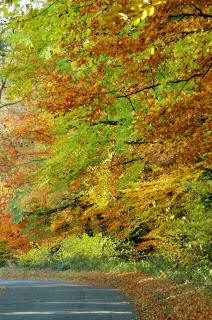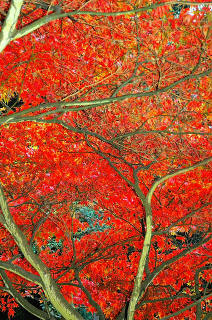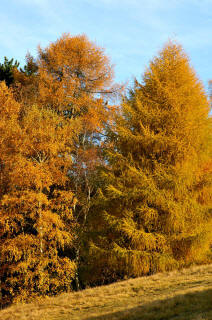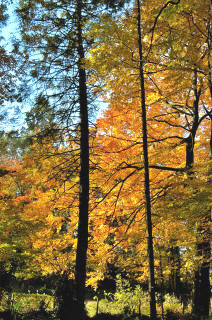Article
Autumn Colours
Towards the end of the year in the northern temperate climates, like
Britain, as it starts to get colder, we have the autumn, or fall. The
deciduous or broad leafed trees detect a climate change, and realise that
they will use more energy than they get, if they were to try to continue to
grow, and with all their leaves on they would be likely to loose branches when
the snow
falls, so they go into a form of hibernation, they stop feeding the leaves, and
they dry out, and fall off. However they are cleverer than this, in that they
extract 'stuff' from them and store it in their roots until wanted again the
next year and flower before the majority of leaves grow, so their flowers are
more visible to insects and pollen can more easily be spread in the wind.
Understanding what's happening, and how colours are produced
|
The process of photosynthesis steadily degrades the supply of chlorophylls
in the foliage, plants normally replenish chlorophylls during the summer months.
It is the chlorophyll pigment that gives the leaves their green colour through
the summer.
When days grow short and nights are cool, or when plants are drought
stressed, deciduous trees decrease chlorophyll pigment production allowing
other pigments present in the leaf to become apparent, resulting in autumn
or fall colours. These other pigments include:
-
Carotenoids that are yellow, brown, and
orange,
-
Anthocyanin pigments which produce reds and purple
colours.
These are not always present in the leaves, but are produced in the foliage
in late summer, when sugars are trapped in the leaves after the process of
abscission begins.
Parts of the world that have showy displays of bright fall/Autumn
colours are
limited to locations where days become short and nights are cool. In other
parts of the world the leaves of deciduous trees simply fall off without
turning the bright colours produced from the accumulation of anthocyanin
pigments.
|


 Click on image
Click on image
to see larger version |
|
Leaf drop or abscission involves complex physiological signals and changes
within plants. A number of deciduous plants remove nitrogen and carbon from
the foliage before they are shed and store them in the form of proteins in
the vacuoles of parenchyma cells in the roots and the inner bark. In the
spring these proteins are used as a nitrogen source during the growth of new
leaves or flowers.
The beginning of leaf drop starts when an abscission layer is formed and
activated between the leaf petiole and the stem. This layer is formed in the
spring during active new growth of the leaf, it consists of layers of cells
that can separate from each other. The cells are sensitive to a plant
hormone called auxin that is produced by the leaf and other parts of the
plant. When the auxin coming from the leaf is produced at a rate consistent
with that of the auxin from the body of the plant, the cells of the
abscission layer remain connected, in the autumn/fall or when under stress,
the auxin flow from the leaf decreases or stops triggering or activating it,
which involves cellular elongation within the abscission layer. The
elongation of these cells break the connection between the different cell
layers, allowing the leaf to break away from the plant, it also forms a
layer that seals the break so the plant does not loose sap. |
 |
Click on smaller
images to see larger version


|
In tropical deciduous forests this same pattern does not
occur, instead they relate to water shortages etc, and this happens at different
times in different places even in close locality or between different plants.
Non deciduous plants like
coniferous trees with needles, don't have the same needs and grow far faster, so
can afford to loose some branches, they don't go through the same cycle.
The best conditions to
create good displays
The best autumn displays come about when you have had a
relatively wet and warm period, (series of low pressure areas) leading up to a
sudden change to a dry spell with cloudless cold nights (high pressure). In
this condition there are loads of the pigments in the leaves and the sudden
triggering of the change means all trees change at the same time, producing a
stronger and more consistent colour change.
Some others say you get good
displays with a dry summer followed by a dry cool autumn, while some others that the brightest colorations usually develop when the days of autumn are bright
and cool, and the nights are chilly but not freezing. |

 Click on smaller
images
Click on smaller
images
to see larger version
 |
|
Geographic variations
If the weather does not change suddenly then as the nights
get colder, the further north trees are affected before the ones in the south,
and often north facing slopes or exposed trees before south facing or trees
bunched closely together.
Knowing when they change
With today's climate
depending on which area of the country you are in will depend on what and
when you will get the colours at their best. In 2008 the
Forestry Commission
 had an online map
that showed the status of very many woods across Britain as the colours
changed. However they do not appear to be doing a similar thing this year,
but taking a look at their website and the
Woodland Trusts had an online map
that showed the status of very many woods across Britain as the colours
changed. However they do not appear to be doing a similar thing this year,
but taking a look at their website and the
Woodland Trusts
 website
as well as keeping
an eye open in your local area will help you identify the best time to catch
this glorious time of year. website
as well as keeping
an eye open in your local area will help you identify the best time to catch
this glorious time of year.
You may be able to find out when different
places traditionally have their best colours,
Westonbirt Arboretum
 in Gloucestershire for
example with its special collections of maples are said to be at its best
towards the end of October. This is later than some other places. Generally
you should start looking out for them from the end of September.
in Gloucestershire for
example with its special collections of maples are said to be at its best
towards the end of October. This is later than some other places. Generally
you should start looking out for them from the end of September.
|
 |
Another article
Finding autumn
colours locations
 takes this further, it also looks at various sources and using maps to find
locations.
takes this further, it also looks at various sources and using maps to find
locations.
See Also:
Autumn Colours

Autumn colours introduction

Photographing autumn
colours

Filters for autumn colours
 l
l
Finding autumn
colour locations

Autumn Colours in England

Autumn Colours in Wales

Autumn Colours in Scotland

Autumn Colours in Northern Ireland

|